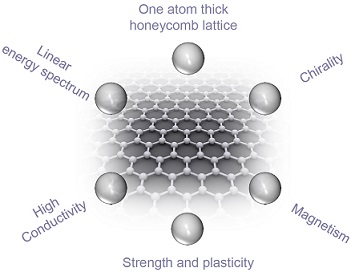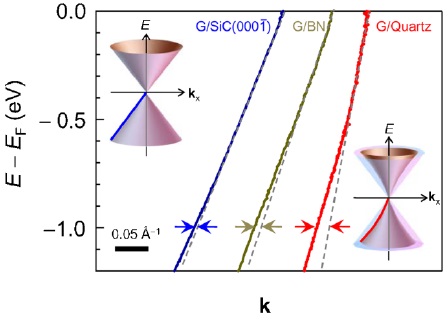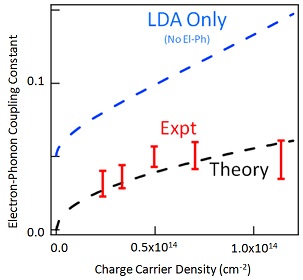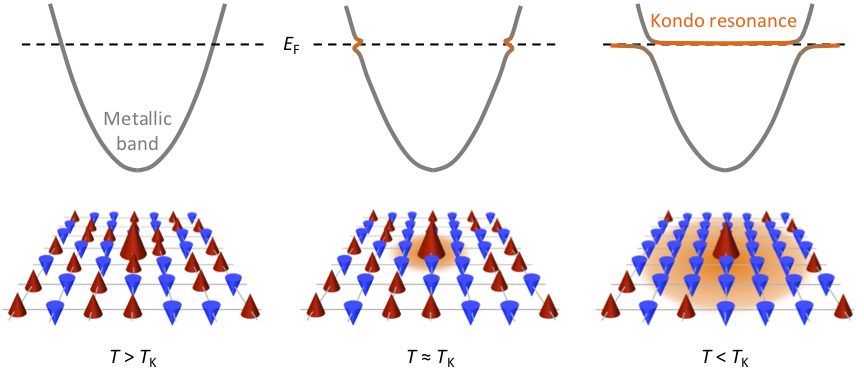Graphene
Graphene is a single layer of carbon atoms arranged in a honeycomb lattice. Its sp2 type bonding character and dimensionally provides excellent strength (200 times stronger than steel) and plasticity of this material. The unique structure of graphene gives linear energy spectrum which is described by Dirac Hamiltonian and imposes characteristic pseudospin nature called as chirality. This exceptional band structure results in high conductivity approaching to ballistic regime and magnetism in graphene.
Based on these properties, graphene exhibits abnormal quantum Hall effect (Nobel prize in 2010) and ultra-high clock speed (100 GHz) in graphene-based transistor, and interesting physics such as half metallicity and quantum spin Hall effect are also expected. Additionally, interesting products such as flexible display and spin valve are under active research worldwide.
Nanoscale 9, 11498 (2017)
New Journal of Physics 18, 043005 (2016)
Scientific Reports 6, 21460 (2016)
RSC Advances 6, 9106 (2016)
Nature Communications 6, 5677 (2015)
Journal of Physics: Condensed Matter 26, 335501 (2014)
Physical Review B 83, 161603(R) (2011)
Journal of Electron Spectroscopy and Related Phenomena 184, 100 (2011)
Physical Review B 81, 241417(R) (2010)
Applied Physics Letters 96, 151913 (2010)
Physical Review B 79, 115439 (2009)
Electron-electron interactions
Straightforward but simple evidence of non-Fermionic behavior of Dirac electrons in graphene is provided by the comparison of energy momentum dispersion of graphene on different dielectric substrate. Upon changing dielectric substrates, (i) the deviation from linearity is enhanced, resulting in the deformation of linear dispersion to a logarithmic one, and (ii) the dispersion becomes steeper approaching the strong electronic correlation limit (epsilon=1).
Resultanly, Fermi velocity, one of the key concepts in the study of a material, as it bears information on a variety of fundamental properties, is inversely proportional to the dielectric constant, providing a new venue to efficiently manipulate the important physical quantity. Furthermore, the fine structure constant of graphene is observed to be cloase to 1, which may indicate that a full theoretical treatment beyond the random-phase approaximation is required to understand this simple 2-dimensional system.
Applied Surface Science 467-478, 1 (2019)
Appied Physics Letters 111, 231603 (2017)
Nano Letters 17, 5914 (2017)
Scientific Reports 2, 590 (2012)
PNAS 108, 11365 (2011)
Electron-phonon interactions
The interaction of electrons and phonons is of practical and fundamental interest in graphene, as it not only affects the transport properties of actual devices, but also induces novel phenomena such as charge density waves.
However, one of the big puzzles in the graphene community is why the experimentally measured electron-phonon interaction appears to be much stronger than the predicted one.
Graphene on a metal (Cu) substrate allows us to modify its electronic properties as the electron-electron interactions are expected to be highly screened, thus removing velocity renormalization due to electronic correlations. As a result, we can extract the real electron-phonon interaction of graphene.
Applied Surface Science 467-478, 1 (2019)
Physical Review B 90, 115417 (2014)
New Journal of Physics 14, 095006 (2012)
Kondo effect
Kondo effect refers the phenemena where the local magnetic moment is screened by the antiferromagnetic spin alignment of free electrons from a metallic background,
forming a resonance-type many-body ground state, so-called Kondo singlet state. The Kondo effect is one of the key elements to understand many-body effects in a solid system
related to its magnetic properties.
However, the two-dimensional nature of the Kondo effect has been barely understood, especially when two-dimensional Kondo lattice has not been realized yet.
We have explored the Kondo effect in a prototypical two-dimensional system, graphene. Kondo impurity and Kondo lattice has been realized in graphene by the presence of
a magnetic impurity, Ce, and by the proximity of topological Kondo insulator, SmB6, respectively. Most importantly, we report, for the first time,
an experimental evidence of the Kondo effect controlled by charge carrier density.
Nano Letters 20, 7973 (2020)
Nano Letters 18, 689 (2018)




